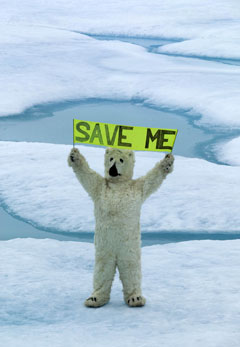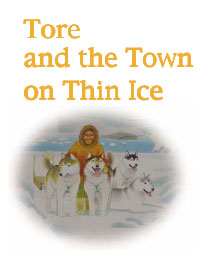Inhofe doesn’t attend climate change meeting but issues statement on children’s book
Inhofe doesn’t attend climate change meeting but issues statement on children’s book
mongabay.com
November 16, 2006
James Inhofe, the outgoing chairman of the Senate Environment and Public Works Committee, dismissed the United Nations climate meeting in Nairobi as “a brainwashing session” and released a statement attacking the body’s new children’s book on the climate change. The Oklahoma Republican, who was the second largest recipient of campaign contributions from oil and gas companies during the 2004 election cycle, has been a vocal opponent of the idea that humans are contributing to global warming, a stance that puts him in opposition with the majority of climate scientists. Inhofe didn’t bother to attend the United Nations Framework Convention on Climate Change which ends tomorrow, but he did find time to issue the following statement* on “Tore and the Town on Thin Ice”, the new children’s book from the U.N.
Majority Fact of the Day: New UN Children’s Book Promotes Global Warming Fears to Kids
Release from the U.S. Senate Committee on Environment and Public Works
MONDAY, NOVEMBER 13, 2006
A new United Nations children’s book promoting fears of catastrophic manmade global warming is being promoted at the UN Climate Change Conference in Kenya. The book’s main character, a young boy, is featured getting so worried about a coming manmade climate disaster that he yells “I don’t want to hear anymore!” The new children’s book, entitled “Tore and the Town on Thin Ice” ((http://www.unep.org/PDF/TORE.pdf)) is published by the United Nations Environment Programme and blames “rich countries” for creating a climate catastrophe and urges children to join environmental groups.

A study released today by the U.S. Geological Survey said global warming is reducing polar bear survival rates. Photo courtesy of Greenpeace |
The book is about a young boy named Tore who lives in an Arctic village. Tore loses a dog sled race because he crashes through the thinning ice allegedly caused by manmade greenhouse gas emissions. The book features colorful drawings and large text to appeal to young children.
After the boy loses the dog sled race, he is visited by “Sedna, the Mother of the Sea” in a dream. The “Sea Mother” Goddess informs Tore in blunt terms that the thinning ice that caused his loss in the dog sled race was due to manmade global warming.
“I’m the one who created and cares for the sea creatures — whales and walruses, seals and fish,” the “Sea Mother” explains to Tore. The “Sea Mother” then tells the boy she will educate him about the reason the ice is thinning.
The morning after his dream, Tore sets out on a quest for knowledge about the dangers of catastrophic manmade global warming. A “snowy owl” informs Tore that “the planet’s heating up” and that both the Arctic and Antarctica “are warming almost twice as fast as elsewhere.” [EPW Note: The Arctic, according to the International Arctic Research Center, was at its warmest in the 20th century during the 1930’s, and both the journals Science and Nature have published studies recently finding — on balance — Antarctica is both cooling and gaining ice.]
The “snowy owl” tells Tore that winning dog sledding races “might not be your top worry” and the owl instead tells the boy that “lots of things are changing fast. Some people who hunt for a living are already going hungry because a lot of seals and walruses are heading north.”
The “snowy owl” also asserts that “the great ice cap here in Greenland—mountains of snow and ice up to about four kilometers thick—is thawing.” [EPW Note: A 2005 study by Ola Johannessen and his colleagues showed that the interior of Greenland is gaining ice mass.]
Next, a polar bear informs Tore that it is hungry because the ice is too thin to stand on and hunt and the bear says that other bears have “starved” because the sea ice went out to sea. The polar bear adds, “We may not have much of a future.” [EPW Note: In May of 2006, biologist Dr. Mitchell Taylor from the Arctic government of Nunavut, a territory of Canada, noted that “of the 13 populations of polar bears in Canada, 11 are stable or increasing in number. They are not going extinct, or even appear to be affected at present.” (http://www.thestar.com/]
The polar bear concludes by telling Tore, “It looks like many animals and fish and birds will go extinct—die out—during your lifetime, partly because of changes in climate.”
The child is described as “at a loss for words” after hearing this grim news and just “stare[s] at the polar bear.”
After a whale appears to present more climate fear, the boy finally screams, “Listen, I’ve had all the bad news I can stand. Our world is melting. Polar bears are starving and all sorts of animals won’t survive. I don’t want to hear anymore!”

Apparently Inhofe isn’t a fan |
The whale responds, “That’s the spirit! Get good and angry. You’ll need all that energy to make a difference.” The whale then goes on to describe computer model projections of future massive coastal flooding and the potential destruction of human life in coastal areas because of the projected sea level rise. [EPW note: Many scientists dispute the notion that mankind has created a climate doomsday. See: ((http://epw.senate.gov/pressitem.cfm?party=rep&id=264777))]
The whale continues, telling the child that more hurricanes and “other things you call natural disasters’ are on their way, too — and they’re getting harsher.” [EPW Note: The relationship between global warming and hurricanes is currently under debate, with the great majority of scientists believing there is little connection. For instance, 2006 was anticipated to be a record year for hurricanes, but turned out to be one of the calmest seasons in many, many years.]
Finally Tore has had enough and asks, “Is there anything at all a kid like me can do?”
The “Sea Mother” tells him of the dangerous effects that an oil- and gas-based energy system has on the climate, and the “Sea Mother” singles out the industrialized world as the cause of her predicted climate catastrophe.
“Rich countries use — and waste — an awful lot of energy. Huge cars. Too many cars instead of efficient trains and buses,” the “Sea Mother explains to Tore. [EPW Fact: Several developing world nations will soon pass the U.S. in greenhouse gas emissions. China alone will pass the U.S. in emissions in 2009. ]
Finally, the “Sea Mother” tells Tore that the solution to the climate crisis can begin in his Arctic village by “setting up solar panels to get electricity from the sun, and modern windmills to capture the energy of the wind.”
The book ends with a section answering the question “What can you do?” The book’s answer includes such suggestions as “join or create an environmental club,” “only drive cars if you must,” and “write to your political leaders.”
*mongabay.com does not take responsibilities for inaccuracies in this statement.
This article uses a news release from the U.S. Senate Committee on Environment and Public Work.







